Do your bit to help preserve local wildlife and make your project that bit more eco-friendly with our extensive range of bird and bat boxes. These hardwearing nesting boxes are built to last, and have been designed in close collaboration with nature conservation organisations and experts from across Europe.
Explore our products
-
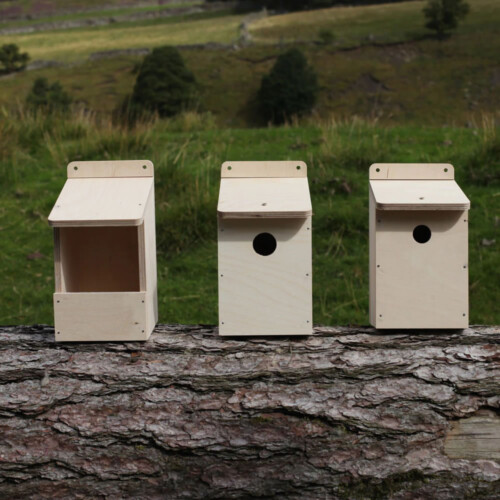 With this fun and accessible Bird Box Kit, you can assemble your own bird boxes at a price that is affordable, and without having to worry about getting the sizes right. All the panels are pre-cut from FSC certified exterior grade plywood, resulting in a bird box that is a durable and hardwearing. Ideal for kids and adults alike, each kit comes with easy-to-follow instructions and contains all the components you need to make your own bird box. You just need to supply a hammer and a screwdriver – and not too much elbow grease! The kit is available in 25mm and 32mm holes sizes, and open fronted versions to suit different birds.
With this fun and accessible Bird Box Kit, you can assemble your own bird boxes at a price that is affordable, and without having to worry about getting the sizes right. All the panels are pre-cut from FSC certified exterior grade plywood, resulting in a bird box that is a durable and hardwearing. Ideal for kids and adults alike, each kit comes with easy-to-follow instructions and contains all the components you need to make your own bird box. You just need to supply a hammer and a screwdriver – and not too much elbow grease! The kit is available in 25mm and 32mm holes sizes, and open fronted versions to suit different birds. -
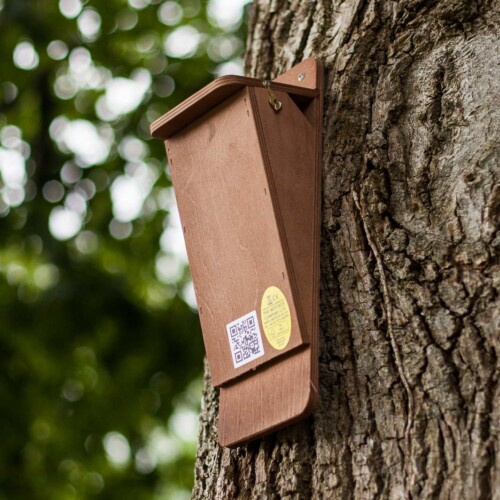 The Treecreeper Nest Box has been designed especially for treecreepers and provides an affordable and hardwearing nesting solution where natural nest sites are rare. Simply mount the box on the trunk of a tree - preferably one with ivy - to encourage the birds to nest. The wedge shape of the box is designed to provide the ideal nesting site for treecreepers. It features small side entrance holes for the birds to access the internal cavity. The removable roof allows for easy access and cleaning. The base of the box has a slot for drainage to ensure it stays dry and comfortable for the residents. The box itself is made from precision cut FSC certified wooden panels treated with water-based, environmentally-friendly preservative for a durable and bird-safe nesting site.
The Treecreeper Nest Box has been designed especially for treecreepers and provides an affordable and hardwearing nesting solution where natural nest sites are rare. Simply mount the box on the trunk of a tree - preferably one with ivy - to encourage the birds to nest. The wedge shape of the box is designed to provide the ideal nesting site for treecreepers. It features small side entrance holes for the birds to access the internal cavity. The removable roof allows for easy access and cleaning. The base of the box has a slot for drainage to ensure it stays dry and comfortable for the residents. The box itself is made from precision cut FSC certified wooden panels treated with water-based, environmentally-friendly preservative for a durable and bird-safe nesting site. -
 This Bat Box Kit is an affordable and fun way to assemble your own bat boxes without having to worry about getting the sizes right. Ideal for a small family project, each pack contains all the components you need to make your own bat box - you just need to supply a hammer, a screwdriver, and a little elbow grease! Each panel for these boxes is pre-cut from FSC certified exterior grade plywood, making them both hardwearing and affordable. The included easy-to-follow instructions mean that no previous experience is required.
This Bat Box Kit is an affordable and fun way to assemble your own bat boxes without having to worry about getting the sizes right. Ideal for a small family project, each pack contains all the components you need to make your own bat box - you just need to supply a hammer, a screwdriver, and a little elbow grease! Each panel for these boxes is pre-cut from FSC certified exterior grade plywood, making them both hardwearing and affordable. The included easy-to-follow instructions mean that no previous experience is required. -
 This House Sparrow Nest Box is a great and affordable way to help support the declining house sparrow population. The box itself is made from precision cut FSC certified wooden panels that have been treated with a water-based, environmentally-friendly preservative that will be a bird-safe and durable nesting site for years to come. The fixed roof allows for the bird box to be fitted right up in the eaves of a house or building, just where the sparrows prefer. Multiple boxes can be joined together or added to the Sparrow Terrace Nest Box to provide an expanding nest site or sites for a growing colony, as house sparrows tend to nest together.
This House Sparrow Nest Box is a great and affordable way to help support the declining house sparrow population. The box itself is made from precision cut FSC certified wooden panels that have been treated with a water-based, environmentally-friendly preservative that will be a bird-safe and durable nesting site for years to come. The fixed roof allows for the bird box to be fitted right up in the eaves of a house or building, just where the sparrows prefer. Multiple boxes can be joined together or added to the Sparrow Terrace Nest Box to provide an expanding nest site or sites for a growing colony, as house sparrows tend to nest together. -
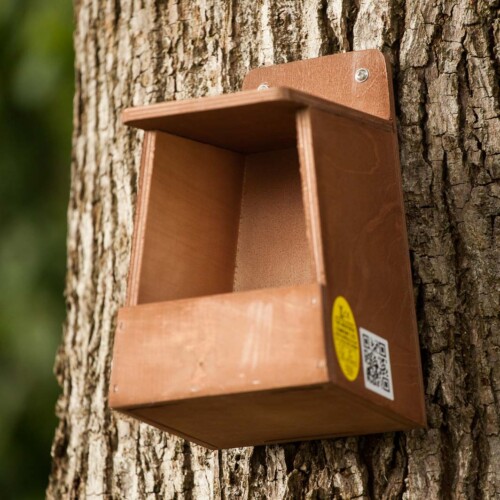 This affordable and hardwearing Robin Nest Box is designed to provide a comfortable home for robins - recently voted the UK’s favourite bird - and other birds such as flycatchers, wagtails and wrens that prefer an open fronted nest box. They are constructed from precision cut FSC certified wooden panels treated with water-based, environmentally-friendly preservative which is kind to birds but helps to ensure a long lasting dry comfortable nest box.
This affordable and hardwearing Robin Nest Box is designed to provide a comfortable home for robins - recently voted the UK’s favourite bird - and other birds such as flycatchers, wagtails and wrens that prefer an open fronted nest box. They are constructed from precision cut FSC certified wooden panels treated with water-based, environmentally-friendly preservative which is kind to birds but helps to ensure a long lasting dry comfortable nest box. -
 This Small Bird Nest Box is specially designed to provide a comfortable, hardwearing nesting site for most common garden birds at an affordable price. It is available in 25mm, 28mm and 32mm hole sizes to allow you to select the hole size for the species you want to attract to your outdoor space. The box itself is made from precision cut FSC certified exterior grade plywood that has been treated with a water-based, environmentally-friendly preservative to ensure a long use life.
This Small Bird Nest Box is specially designed to provide a comfortable, hardwearing nesting site for most common garden birds at an affordable price. It is available in 25mm, 28mm and 32mm hole sizes to allow you to select the hole size for the species you want to attract to your outdoor space. The box itself is made from precision cut FSC certified exterior grade plywood that has been treated with a water-based, environmentally-friendly preservative to ensure a long use life. -
 The Tree Sparrow Nest Box is a great way to help the declining tree sparrow population. All you need to do is put up one or more of these affordable and hardwearing nesting boxes - designed especially for tree sparrows - in your trees, hedges, fences, or buildings. It features a fixed roof which keeps out the weather and allows for fitting one box right on top of another, in close proximity, or joined together to provide nest sites for a growing colony of sparrows. The 28mm entrance hole box is ideal size and dimension for tree sparrows. Made from precision cut FSC certified wooden panels that have been treated with a water based environmentally-friendly preservative, it makes for a durable bird-safe home for sparrows.
The Tree Sparrow Nest Box is a great way to help the declining tree sparrow population. All you need to do is put up one or more of these affordable and hardwearing nesting boxes - designed especially for tree sparrows - in your trees, hedges, fences, or buildings. It features a fixed roof which keeps out the weather and allows for fitting one box right on top of another, in close proximity, or joined together to provide nest sites for a growing colony of sparrows. The 28mm entrance hole box is ideal size and dimension for tree sparrows. Made from precision cut FSC certified wooden panels that have been treated with a water based environmentally-friendly preservative, it makes for a durable bird-safe home for sparrows. -
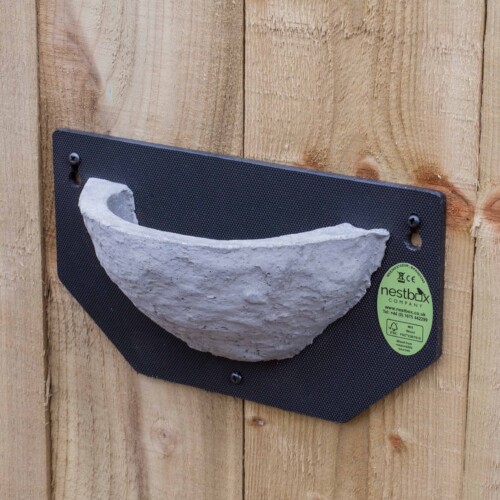 The Eco Swallow Nest is an affordable and hardwearing artificial nest cup specially designed to attract swallows. The nest consists of a moulded resin/concrete/terracotta bowl fitted onto attractive backing plate made from 100% recycled plastic. Based on the size and shape of natural swallow nests, swallows will readily use these nest cups when placed in garages, sheds, stables, or barns – and even outdoor spaces like under archways. Swallows are sociable birds but it is advisable to not place the nest cups too close together. A minimum distance of 1m between nest cups is suggested. When fitted in such locations that also allow constant access throughout the breeding season, the nest will give many years of use without the need for any maintenance. This means there will be no costs apart from the initial outlay.
The Eco Swallow Nest is an affordable and hardwearing artificial nest cup specially designed to attract swallows. The nest consists of a moulded resin/concrete/terracotta bowl fitted onto attractive backing plate made from 100% recycled plastic. Based on the size and shape of natural swallow nests, swallows will readily use these nest cups when placed in garages, sheds, stables, or barns – and even outdoor spaces like under archways. Swallows are sociable birds but it is advisable to not place the nest cups too close together. A minimum distance of 1m between nest cups is suggested. When fitted in such locations that also allow constant access throughout the breeding season, the nest will give many years of use without the need for any maintenance. This means there will be no costs apart from the initial outlay. -
 The Eco Robin Nest Box is a durable and well-priced open fronted nest box. Its shape and size were chosen in consultation with ornithologists to appeal to smaller bird species such as robins, wrens and pied wagtails. It is made to robust and long-lasting construction parameters; comprising a recycled plastic outer shell with wooden internal nesting chamber made from oriented strand board. The outer shell is precision cut and uses a clever arrangement of tabs to hold the weatherproof shell together. This further extends the lifespan as there are no fixings that could rust or degrade over time. The nesting chamber is easy to check and clean by twisting the fastening at the bottom, causing it to slide out of the outer shell.
The Eco Robin Nest Box is a durable and well-priced open fronted nest box. Its shape and size were chosen in consultation with ornithologists to appeal to smaller bird species such as robins, wrens and pied wagtails. It is made to robust and long-lasting construction parameters; comprising a recycled plastic outer shell with wooden internal nesting chamber made from oriented strand board. The outer shell is precision cut and uses a clever arrangement of tabs to hold the weatherproof shell together. This further extends the lifespan as there are no fixings that could rust or degrade over time. The nesting chamber is easy to check and clean by twisting the fastening at the bottom, causing it to slide out of the outer shell. -
 This Eco Small Bird Box features an exceptional and inventive construction that will provide an affordable and hardwearing home for tits, sparrows and flycatchers depending on the chosen entrance hole size. There are three entrance hole options available: 25m, 28mm, and 32mm. The recycled plastic outer shell in combination with the wooden internal nesting chamber provides a robust, long lasting and comfortable home for most common garden birds. The external box consists of a weatherproof outer shell made from UV stabilised 100% recycled plastic, while the inside the inner shell is a wooden nest box made from oriented strand board to provide the ideal environment for birds to nest in. The outer shell has been precision cut and uses a system of tabs to hold it together after assembly. This further extends the lifespan of the box ensuring that there are no fixings holding the weatherproof shell together that could rust or degrade over time. The 25mm entrance hole is primarily suitable for the smallest tit species such as blue tits, coal tits, and marsh tits. The 28mm diameter hole will attract all these species but also great tits, crested tits, and tree sparrows. The largest option, 32mm, will attract a larger range of species including house sparrows, great tits, nuthatches, and pied flycatchers.
This Eco Small Bird Box features an exceptional and inventive construction that will provide an affordable and hardwearing home for tits, sparrows and flycatchers depending on the chosen entrance hole size. There are three entrance hole options available: 25m, 28mm, and 32mm. The recycled plastic outer shell in combination with the wooden internal nesting chamber provides a robust, long lasting and comfortable home for most common garden birds. The external box consists of a weatherproof outer shell made from UV stabilised 100% recycled plastic, while the inside the inner shell is a wooden nest box made from oriented strand board to provide the ideal environment for birds to nest in. The outer shell has been precision cut and uses a system of tabs to hold it together after assembly. This further extends the lifespan of the box ensuring that there are no fixings holding the weatherproof shell together that could rust or degrade over time. The 25mm entrance hole is primarily suitable for the smallest tit species such as blue tits, coal tits, and marsh tits. The 28mm diameter hole will attract all these species but also great tits, crested tits, and tree sparrows. The largest option, 32mm, will attract a larger range of species including house sparrows, great tits, nuthatches, and pied flycatchers. -
 The Eco House Martin Nest Box is an artificial, hardwearing nest cup designed to match the size and shape of natural house martin nests. The nest is made from moulded resin/concrete/terracotta, comprising a bowl fixed to and attractive backing plate and roof constructed from 100% recycled waste plastic. The roof design protects the nest from adverse weather, and allows the nest to be sited just under the eaves of your building. When fitted in a suitable location, this nest will last for many years without any maintenance, making this affordable nesting option also a very durable one. Position the nest beneath the eaves of the building at a minimum height of 2m for the best results. House martins often prefer to nest on east or north facing walls but the nest can be placed in walls facing any direction. The Eco House Martin Nest means birds use less energy to produce their nest and do not need to find suitable nest building mud at a time of year when food and nesting materials can be in short supply.
The Eco House Martin Nest Box is an artificial, hardwearing nest cup designed to match the size and shape of natural house martin nests. The nest is made from moulded resin/concrete/terracotta, comprising a bowl fixed to and attractive backing plate and roof constructed from 100% recycled waste plastic. The roof design protects the nest from adverse weather, and allows the nest to be sited just under the eaves of your building. When fitted in a suitable location, this nest will last for many years without any maintenance, making this affordable nesting option also a very durable one. Position the nest beneath the eaves of the building at a minimum height of 2m for the best results. House martins often prefer to nest on east or north facing walls but the nest can be placed in walls facing any direction. The Eco House Martin Nest means birds use less energy to produce their nest and do not need to find suitable nest building mud at a time of year when food and nesting materials can be in short supply. -
 This Traditional Bat Box is designed for small crevice dwelling bats, especially pipistrelles. The box is made from precision cut FSC certified panels, ensuring a dry, draught free, long-lasting box at an affordable price. It has a 20mm entrance slot, specially sized to deter birds while being ideal for small bats. The box’s grooved landing ladder continues internally for ease of access, and its flexible construction allows it to be easily changed to a single chamber bat box by sliding out the internal divider.
This Traditional Bat Box is designed for small crevice dwelling bats, especially pipistrelles. The box is made from precision cut FSC certified panels, ensuring a dry, draught free, long-lasting box at an affordable price. It has a 20mm entrance slot, specially sized to deter birds while being ideal for small bats. The box’s grooved landing ladder continues internally for ease of access, and its flexible construction allows it to be easily changed to a single chamber bat box by sliding out the internal divider. -
 The Starling Nest Box features a 45mm entrance hole especially designed for starlings. This affordable and hardwearing box is easy to mount on buildings or trees to provide a dry, comfortable nest site for starlings. Ideally, put up a few of these bird boxes at 2.5m or higher above the ground on adjacent trees or buildings to encourage a loose colony to form. The box itself is made from precision cut FSC certified plywood panels that have been treated with water-based, environmentally-friendly preservative to ensure a long-lasting and bird-safe nesting space.
The Starling Nest Box features a 45mm entrance hole especially designed for starlings. This affordable and hardwearing box is easy to mount on buildings or trees to provide a dry, comfortable nest site for starlings. Ideally, put up a few of these bird boxes at 2.5m or higher above the ground on adjacent trees or buildings to encourage a loose colony to form. The box itself is made from precision cut FSC certified plywood panels that have been treated with water-based, environmentally-friendly preservative to ensure a long-lasting and bird-safe nesting space. -
 This Crevice Bat Box is specially designed to meet the needs of small crevice dwelling bats, especially pipistrelles. It has black external surfaces black to increase heat absorption, while the internal ceramic heat sinks retain and stabilise the box temperature. The grooved landing ladder continues internally for ease of access. The box itself is constructed from precision-cut FSC certified panels for a dry, draught free, long-lasting box at a price that is affordable. This product is available in two sizes: double or treble crevice.
This Crevice Bat Box is specially designed to meet the needs of small crevice dwelling bats, especially pipistrelles. It has black external surfaces black to increase heat absorption, while the internal ceramic heat sinks retain and stabilise the box temperature. The grooved landing ladder continues internally for ease of access. The box itself is constructed from precision-cut FSC certified panels for a dry, draught free, long-lasting box at a price that is affordable. This product is available in two sizes: double or treble crevice. -
 The Eco Starling Nest Box features a 45mm entrance hole especially designed for starlings, a native UK species whose numbers are in decline. This affordable and hardwearing box comprises an innovative recycled plastic outer shell and a wooden internal nesting chamber made from oriented strand board. The construction method provides a robust, long lasting and comfortable home for starlings. Starlings tend to favour higher nesting sites, so where possible, place the box 2.5m or higher above the ground on a tree or external wall of a building. If you have the opportunity to do so, place a few of these boxes on adjacent trees or buildings to encourage a loose colony to form.
The Eco Starling Nest Box features a 45mm entrance hole especially designed for starlings, a native UK species whose numbers are in decline. This affordable and hardwearing box comprises an innovative recycled plastic outer shell and a wooden internal nesting chamber made from oriented strand board. The construction method provides a robust, long lasting and comfortable home for starlings. Starlings tend to favour higher nesting sites, so where possible, place the box 2.5m or higher above the ground on a tree or external wall of a building. If you have the opportunity to do so, place a few of these boxes on adjacent trees or buildings to encourage a loose colony to form. -
 This Cavity Bat Box has been designed with British cavity roosting bats in mind, including brown long-eared bats and Myotis species. The black external surfaces increase heat absorption, while the internal ceramic heat sinks retain and stabilise the temperature of the box. The grooved landing ladder continues internally to improve access and the inside of the roof has grooves to make it easy for bats to hang and cluster. The box itself is manufactured from precision cut FSC certified panels for a dry, draught free, durable box at an affordable price.
This Cavity Bat Box has been designed with British cavity roosting bats in mind, including brown long-eared bats and Myotis species. The black external surfaces increase heat absorption, while the internal ceramic heat sinks retain and stabilise the temperature of the box. The grooved landing ladder continues internally to improve access and the inside of the roof has grooves to make it easy for bats to hang and cluster. The box itself is manufactured from precision cut FSC certified panels for a dry, draught free, durable box at an affordable price. -
 This Large Bird Nest Box is an affordable, versatile large bird box - three times the size of other boxes - specially designed to attract a range of species including jackdaws, doves, tree nesting ducks, and pigeons. It’s also the ideal size for tree nesting ducks such as goosanders and goldeneye as it features a large front aperture and hinged lid for easy access, plus a drained floor to ensure residents stay warm and dry. This nest box is made from precision cut FSC certified panels that have been treated with a water-based environmentally-friendly preservative to provide a nesting space that is bird-safe and hardwearing.
This Large Bird Nest Box is an affordable, versatile large bird box - three times the size of other boxes - specially designed to attract a range of species including jackdaws, doves, tree nesting ducks, and pigeons. It’s also the ideal size for tree nesting ducks such as goosanders and goldeneye as it features a large front aperture and hinged lid for easy access, plus a drained floor to ensure residents stay warm and dry. This nest box is made from precision cut FSC certified panels that have been treated with a water-based environmentally-friendly preservative to provide a nesting space that is bird-safe and hardwearing. -
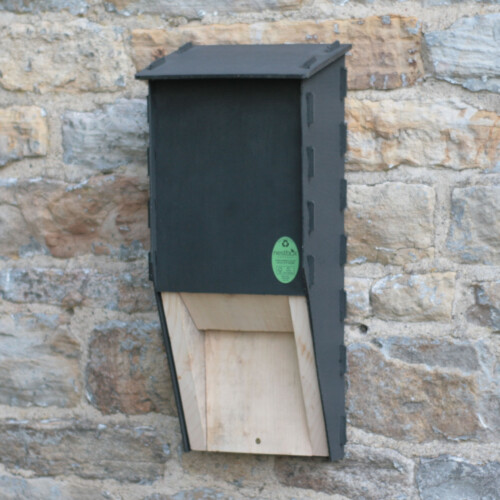 This Eco Bat Box has had a design update and now features a hardwearing, weatherproof recycled plastic exterior and a UK grown, locally sourced FSC wooden internal roost chamber to create an attractive roosting space for bats. The box itself is available with two different roost chambers designed for either crevice or cavity roosting bats. Its self-cleaning design requires no maintenance, so there’s no additional cost or work after the affordable initial outlay for the box itself.
This Eco Bat Box has had a design update and now features a hardwearing, weatherproof recycled plastic exterior and a UK grown, locally sourced FSC wooden internal roost chamber to create an attractive roosting space for bats. The box itself is available with two different roost chambers designed for either crevice or cavity roosting bats. Its self-cleaning design requires no maintenance, so there’s no additional cost or work after the affordable initial outlay for the box itself. -
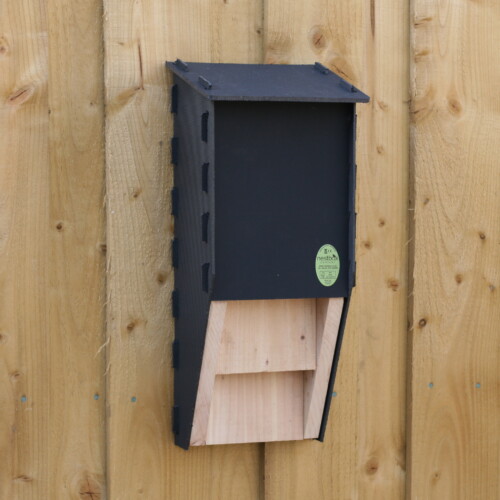 This Eco Kent Bat Box was inspired by the proven and popular Kent bat box design, but has since been given an additional weatherproof outer shell that makes it ideal for crevice roosting species such as common and soprano pipistrelles. The 100% recycled plastic shell protects the wooden interior, making this bat box reliable and durable. The interior is made from FSC Certified spruce, rough-sawn to provide good grip for the bats. It is also a self-cleaning and maintenance free box, ensuring the bats can remain undisturbed while roosting.
This Eco Kent Bat Box was inspired by the proven and popular Kent bat box design, but has since been given an additional weatherproof outer shell that makes it ideal for crevice roosting species such as common and soprano pipistrelles. The 100% recycled plastic shell protects the wooden interior, making this bat box reliable and durable. The interior is made from FSC Certified spruce, rough-sawn to provide good grip for the bats. It is also a self-cleaning and maintenance free box, ensuring the bats can remain undisturbed while roosting. -
 This Tawny Owl Nest Box provides a safe and comfortable nest site for this fascinating species. The box is manufactured from precision cut FSC certified exterior grade plywood to ensure that it is durable, affordable, and long-lasting. It features a well-drained floor area, and also has as a hatch that allows for easy access to the nesting area. No fixings are required for this box, simply strap it to a branch or attach it to a batten. For the best results, however, place this box in forests and other wooded environments.
This Tawny Owl Nest Box provides a safe and comfortable nest site for this fascinating species. The box is manufactured from precision cut FSC certified exterior grade plywood to ensure that it is durable, affordable, and long-lasting. It features a well-drained floor area, and also has as a hatch that allows for easy access to the nesting area. No fixings are required for this box, simply strap it to a branch or attach it to a batten. For the best results, however, place this box in forests and other wooded environments. -
 Redesigned in 2016 and based on the highly successful Zeist design, this Swift Nest Box is designed especially for swifts. It has been developed to provide an excellent roosting and nesting spot at an affordable price. Hardwearing and durable, this box is manufactured from precision cut FSC certified exterior grade plywood panels. The panels have been treated with a water-based, environmentally-friendly preservative to ensure a long-lasting product. Comprising a single compartment nesting area accessed through an oval entrance hole in overhanging front panel, the box is ideally placed high up under the eaves on buildings. It was modified in 2017 to a 28mm x 65mm entrance as a result of recent research findings and is specially designed to keep starlings and sparrows from occupying the box.
Redesigned in 2016 and based on the highly successful Zeist design, this Swift Nest Box is designed especially for swifts. It has been developed to provide an excellent roosting and nesting spot at an affordable price. Hardwearing and durable, this box is manufactured from precision cut FSC certified exterior grade plywood panels. The panels have been treated with a water-based, environmentally-friendly preservative to ensure a long-lasting product. Comprising a single compartment nesting area accessed through an oval entrance hole in overhanging front panel, the box is ideally placed high up under the eaves on buildings. It was modified in 2017 to a 28mm x 65mm entrance as a result of recent research findings and is specially designed to keep starlings and sparrows from occupying the box. -
 The Sparrow Terrace Nest Box is an affordable way for you to help the declining sparrow population. It’s as simple as by just putting up one of these bird boxes designed especially for use by house sparrow colonies. The box itself is constructed from precision cut FSC certified wooden panels and treated with water-based, environmentally-friendly preservative to make the bird box durable and hardwearing, perfect for outdoor use. Its fixed roof enables the bird nesting box to be fitted right up in the eaves, just where the sparrows prefer to nest. Each terrace box can accommodate a host of sparrows - up to three nesting pairs.
The Sparrow Terrace Nest Box is an affordable way for you to help the declining sparrow population. It’s as simple as by just putting up one of these bird boxes designed especially for use by house sparrow colonies. The box itself is constructed from precision cut FSC certified wooden panels and treated with water-based, environmentally-friendly preservative to make the bird box durable and hardwearing, perfect for outdoor use. Its fixed roof enables the bird nesting box to be fitted right up in the eaves, just where the sparrows prefer to nest. Each terrace box can accommodate a host of sparrows - up to three nesting pairs. -
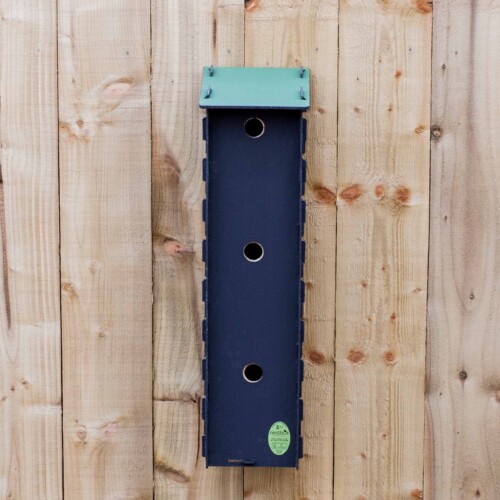 The Eco Sparrow Tower is an exceptional and advanced bird box that offers nesting places for up to three pairs of house sparrows. Its unique construction and robust materials ensure the box is both affordable and hardwearing. The outer box is made from UV stabilised 100% recycled plastic, while the internal nesting chambers are contained in a wooden nest box made from oriented strand board: an ideal environment for birds to nest in. The sparrow population is sadly in decline, and you can play your part in combatting that by putting up one of these bird boxes that will accommodate multiple pairs of nesting sparrows. The box has a fixed roof to enable the sparrow tower to be fitted right up in the eaves just where the sparrows prefer to nest.
The Eco Sparrow Tower is an exceptional and advanced bird box that offers nesting places for up to three pairs of house sparrows. Its unique construction and robust materials ensure the box is both affordable and hardwearing. The outer box is made from UV stabilised 100% recycled plastic, while the internal nesting chambers are contained in a wooden nest box made from oriented strand board: an ideal environment for birds to nest in. The sparrow population is sadly in decline, and you can play your part in combatting that by putting up one of these bird boxes that will accommodate multiple pairs of nesting sparrows. The box has a fixed roof to enable the sparrow tower to be fitted right up in the eaves just where the sparrows prefer to nest. -
 This Eco Bat Access Box is ideal for ensuring continued access to established bat roosts when refurbishing and renovating buildings. Its design allows it to be easily integrated into brickwork, stonework and external insulation and its open back provides a bat friendly entrance for easy entry to cavity walls and/or existing roost sites. The box itself is comprised of a recycled plastic weatherproof shell with internal wooden chamber, ensuring this product is both hardwearing and easy on the pocket. This box comes with a choice of brick or black coloured front panels.
This Eco Bat Access Box is ideal for ensuring continued access to established bat roosts when refurbishing and renovating buildings. Its design allows it to be easily integrated into brickwork, stonework and external insulation and its open back provides a bat friendly entrance for easy entry to cavity walls and/or existing roost sites. The box itself is comprised of a recycled plastic weatherproof shell with internal wooden chamber, ensuring this product is both hardwearing and easy on the pocket. This box comes with a choice of brick or black coloured front panels. -
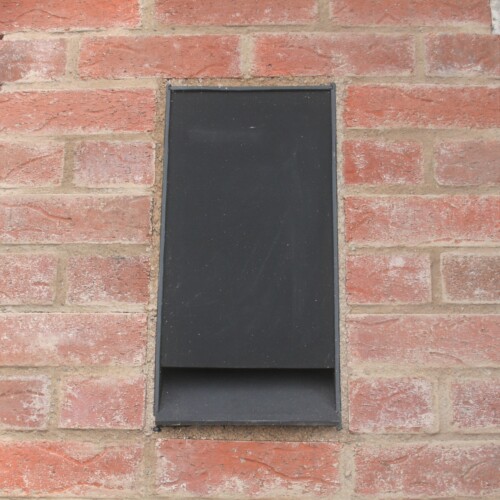 This Integrated Eco Bat Box is a built-in bat box designed to provide a permanent bat roost in buildings, perfectly sized to replace six standard UK bricks without obstructing the cavity. Its design also makes it equally suited to fitting in timber cladding, random stone and external insulation environments, while being self-cleaning and requiring no maintenance. The itself box is constructed from a recycled plastic weatherproof shell with internal wooden roost chamber. This affordable bat box is available with specific internal roost chamber formats for crevice or cavity roosting bats and comes with brick, green or black coloured front panels.
This Integrated Eco Bat Box is a built-in bat box designed to provide a permanent bat roost in buildings, perfectly sized to replace six standard UK bricks without obstructing the cavity. Its design also makes it equally suited to fitting in timber cladding, random stone and external insulation environments, while being self-cleaning and requiring no maintenance. The itself box is constructed from a recycled plastic weatherproof shell with internal wooden roost chamber. This affordable bat box is available with specific internal roost chamber formats for crevice or cavity roosting bats and comes with brick, green or black coloured front panels. -
 This Eco Tawny Owl nest box is hardwearing and long-lasting, making it the perfect nesting environment for a pair of tawny owls. It consists of a unique and inventive construction, with a recycled plastic outer shell encasing a wooden internal nesting chamber. This owl nest box was designed by professional ornithologists in the UK to provide a safe and comfortable roosting option for the UK's most abundant and widespread owl. This affordable owl box is easy to install securely on a suitable tree or wall.
This Eco Tawny Owl nest box is hardwearing and long-lasting, making it the perfect nesting environment for a pair of tawny owls. It consists of a unique and inventive construction, with a recycled plastic outer shell encasing a wooden internal nesting chamber. This owl nest box was designed by professional ornithologists in the UK to provide a safe and comfortable roosting option for the UK's most abundant and widespread owl. This affordable owl box is easy to install securely on a suitable tree or wall. -
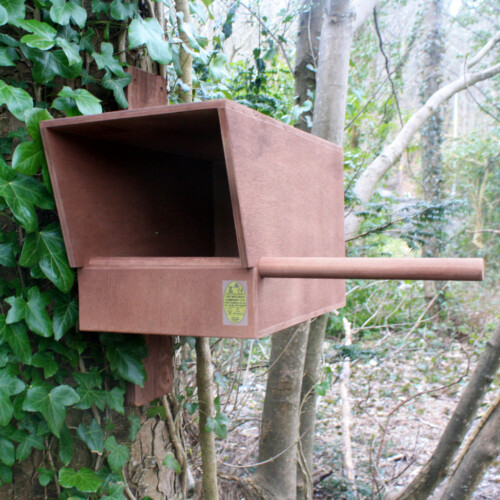 This Kestrel Nest Box is affordable and easy to mount, designed by experts especially for kestrels. The box comprises a 100mm deep canopy, a generous 100mm entrance lip, a spacious nesting area and a sturdy perch. It is easy to install the box on a tree or wall thanks to the integral side mounting strip. The box is best mounted high up on a wall, tree, or pole with good panoramic views to attract nesting kestrels but facing away from the prevailing weather. These bird boxes are normally supplied right-handed but can be made left-handed at your request. The nest box is made from precision cut FSC certified exterior plywood treated with a water-based, environmentally-friendly preservative to ensure a hardwearing and safe home for this majestic bird.
This Kestrel Nest Box is affordable and easy to mount, designed by experts especially for kestrels. The box comprises a 100mm deep canopy, a generous 100mm entrance lip, a spacious nesting area and a sturdy perch. It is easy to install the box on a tree or wall thanks to the integral side mounting strip. The box is best mounted high up on a wall, tree, or pole with good panoramic views to attract nesting kestrels but facing away from the prevailing weather. These bird boxes are normally supplied right-handed but can be made left-handed at your request. The nest box is made from precision cut FSC certified exterior plywood treated with a water-based, environmentally-friendly preservative to ensure a hardwearing and safe home for this majestic bird. -
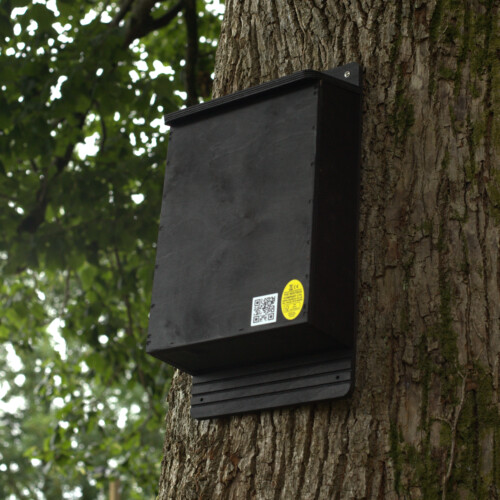 This Roost Maternity Bat Box is designed for larger roosts or maternity colonies of crevice dwelling bats, especially Pipistrelles. It has black external surfaces black to increase heat absorption, and internal ceramic heat sinks to retain and stabilise the temperature of the box. The grooved landing ladder continues internally to improve access. The box itself is manufactured from precision cut FSC certified panels to provide a dry, draught free, long-lasting box at a price that offers great value.
This Roost Maternity Bat Box is designed for larger roosts or maternity colonies of crevice dwelling bats, especially Pipistrelles. It has black external surfaces black to increase heat absorption, and internal ceramic heat sinks to retain and stabilise the temperature of the box. The grooved landing ladder continues internally to improve access. The box itself is manufactured from precision cut FSC certified panels to provide a dry, draught free, long-lasting box at a price that offers great value. -
 This Interior Barn Owl Nest Box is an ideal roosting and nesting space for use in indoor built environments. Its modular design makes it safer and easier to install than conventional nesting boxes, as each individual panel can be carried and lifted individually then slotted into position. All panels are precision cut from FSC Certified exterior grade plywood, providing a nest box that is reliable, affordable and incredibly convenient. This owl box is simple to mount in suitable locations such as walls, joists or beams.
This Interior Barn Owl Nest Box is an ideal roosting and nesting space for use in indoor built environments. Its modular design makes it safer and easier to install than conventional nesting boxes, as each individual panel can be carried and lifted individually then slotted into position. All panels are precision cut from FSC Certified exterior grade plywood, providing a nest box that is reliable, affordable and incredibly convenient. This owl box is simple to mount in suitable locations such as walls, joists or beams. -
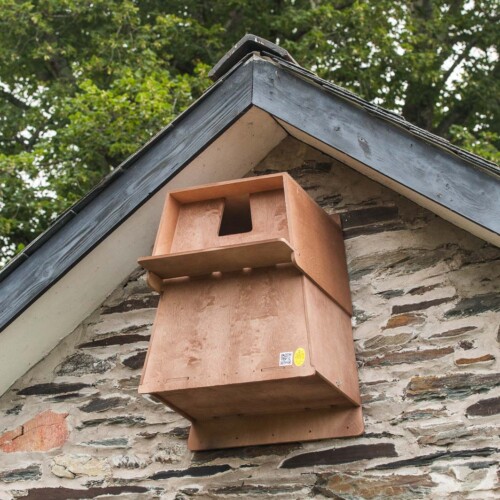 This hardwearing and competitively priced Barn Owl Nest Box has been designed after consulting with the Barn Owl Trust and other bird experts to provide the safest and most comfortable roosting and nesting site for this well-loved species at an affordable price. The box itself is constructed from exterior grade FSC certified plywood and treated with a bird safe and environmentally friendly preservative. Precision cut panels ensure a dry and draught free box, while the premium quality construction materials were chosen to ensure a long life for these valuable nesting and roosting spaces. The Barn Owl Nest Box is supplied fully assembled with the exception of its landing/exercise/roosting platform.
This hardwearing and competitively priced Barn Owl Nest Box has been designed after consulting with the Barn Owl Trust and other bird experts to provide the safest and most comfortable roosting and nesting site for this well-loved species at an affordable price. The box itself is constructed from exterior grade FSC certified plywood and treated with a bird safe and environmentally friendly preservative. Precision cut panels ensure a dry and draught free box, while the premium quality construction materials were chosen to ensure a long life for these valuable nesting and roosting spaces. The Barn Owl Nest Box is supplied fully assembled with the exception of its landing/exercise/roosting platform.

